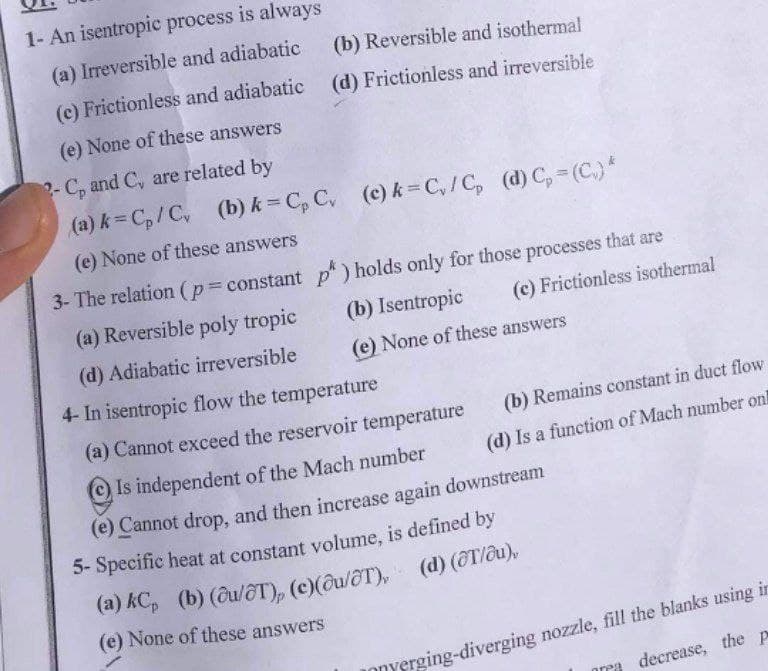1- An isentropic (a) Irreversible and adiabatic (b) Reversible and isothermal (c) Frictionless and adiabatic (d) Frictionless and irreversible (e) None of these answers 2- C, and C, are related by (a) k = C,/ C, (b)k=C, C, (c) k= C, /C, (d) C, (C.) * (e) None of these answers p*) holds only for those processes that are tionless isotherma atant
1- An isentropic (a) Irreversible and adiabatic (b) Reversible and isothermal (c) Frictionless and adiabatic (d) Frictionless and irreversible (e) None of these answers 2- C, and C, are related by (a) k = C,/ C, (b)k=C, C, (c) k= C, /C, (d) C, (C.) * (e) None of these answers p*) holds only for those processes that are tionless isotherma atant
Elements Of Electromagnetics
7th Edition
ISBN:9780190698614
Author:Sadiku, Matthew N. O.
Publisher:Sadiku, Matthew N. O.
ChapterMA: Math Assessment
Section: Chapter Questions
Problem 1.1MA
Related questions
Question
I need the answer as soon as possible

Transcribed Image Text:1- An isentropic process is always
(a) Irreversible and adiabatic
(b) Reversible and isothermal
(c) Frictionless and adiabatic (d) Frictionless and irreversible
(e) None of these answers
2- C, and C, are related by
(a) k= C,/C,
(b) k = C, C, (c) k = C,/C, (d) C, = (C.)*
(e) None of these answers
3- The relation (p constant p) holds only for those processes that are
(a) Reversible poly tropic
(b) Isentropic
(c) Frictionless isothermal
(d) Adiabatic irreversible
(e) None of these answers
4- In isentropic flow the temperature
(a) Cannot exceed the reservoir temperature
(b) Remains constant in duct flow
Is independent of the Mach number
(d) Is a function of Mach number on!
(e) Cannot drop, and then increase again downstream
5- Specific heat at constant volume, is defined by
(e) None of these answers
JOnYerging-diverging nozzle, fill the blanks using in
decrease, the p
area
Expert Solution
This question has been solved!
Explore an expertly crafted, step-by-step solution for a thorough understanding of key concepts.
This is a popular solution!
Trending now
This is a popular solution!
Step by step
Solved in 2 steps

Knowledge Booster
Learn more about
Need a deep-dive on the concept behind this application? Look no further. Learn more about this topic, mechanical-engineering and related others by exploring similar questions and additional content below.Recommended textbooks for you

Elements Of Electromagnetics
Mechanical Engineering
ISBN:
9780190698614
Author:
Sadiku, Matthew N. O.
Publisher:
Oxford University Press

Mechanics of Materials (10th Edition)
Mechanical Engineering
ISBN:
9780134319650
Author:
Russell C. Hibbeler
Publisher:
PEARSON

Thermodynamics: An Engineering Approach
Mechanical Engineering
ISBN:
9781259822674
Author:
Yunus A. Cengel Dr., Michael A. Boles
Publisher:
McGraw-Hill Education

Elements Of Electromagnetics
Mechanical Engineering
ISBN:
9780190698614
Author:
Sadiku, Matthew N. O.
Publisher:
Oxford University Press

Mechanics of Materials (10th Edition)
Mechanical Engineering
ISBN:
9780134319650
Author:
Russell C. Hibbeler
Publisher:
PEARSON

Thermodynamics: An Engineering Approach
Mechanical Engineering
ISBN:
9781259822674
Author:
Yunus A. Cengel Dr., Michael A. Boles
Publisher:
McGraw-Hill Education

Control Systems Engineering
Mechanical Engineering
ISBN:
9781118170519
Author:
Norman S. Nise
Publisher:
WILEY

Mechanics of Materials (MindTap Course List)
Mechanical Engineering
ISBN:
9781337093347
Author:
Barry J. Goodno, James M. Gere
Publisher:
Cengage Learning

Engineering Mechanics: Statics
Mechanical Engineering
ISBN:
9781118807330
Author:
James L. Meriam, L. G. Kraige, J. N. Bolton
Publisher:
WILEY